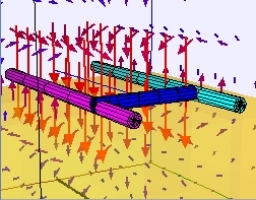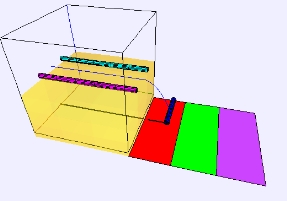Rail Gun
Model
The EJS Rail Gun
Model shows a rail gun
created by running current through long rods with a cross-rod
accelerated due to the external field from the current in the rails. It
also shows the magnetic field that the cross-rod experiences. Students
can adjust the current in the rails and rod as well as the spacing
between the rails.
Exercises:
- Run the simulation. The
cross-rod, resting on frictionless rails, initially begins at rest and
is accelerated due to the
magnetic field. You can zoom in (Shift-Click-Drag),
rotate (Click-Drag)
or pan (Ctrl-Click-Drag)
the 3D views. Pause the simulation before the cross-rod drops leaves
the rails. What is the direction of the magnetic field due to
the current in the (the magnetic field outside each rail is
approximated as the field from the end of a very long wire: B = μ0I/4πR)?
Looking at the magnetic field, what direction is the current flowing
through the blue cross-rod (from the pink rail to the cyan rail or vice
versa)?
- When the cross-rod lands, it
has fallen 5 cm down from the yellow box to the carpet. The simulation
reports the distance it travels from
the edge. How does this distance depend on current (in amps)
and distance between the rods (in cm)?
- To calculate the external
field of the cross-rod, the simulation uses the value of the magnetic
field due to the two rails in the middle. Treating each rail
as a
long wire gives a field at
the end of each rail of B = μ0I/4πR
(where R is
the distance from the rail). Show that B =
(μ0
I/4π)(4/L) is the field in the mid-point (a distance L/2 from
each
rail) between the two rails (that would be experienced by the center of
the rod). Assuming this constant magnetic field, what is the value of
the force on the rod? If the
rails are 10 cm long and each of the
landing mats is 4 cm wide and the mass of the rod is 1-g (independent
of its length), what current is required for the rod to land where the
red and green mats meet (after falling a distance of 5 cm down)? the
green and purple meet? the edge of the
purple? Show your work and verify your answers using the simulation.
- Click on the Show B(x)
check-box. This shows the magnetic field as a funciton of position
between the rails. Given that the simulation uses the value of the
magnetic field in the middle of the rails, how would you expect the
simulation to change if the variation in the magnetic field were taken
into account? Specifically, what would happen to the trajectory of the
cross-rod?
- Show that the equation of
the field as a function of position between the rails is given by B(x)=
(μ0I/2π)(L/(L2-x2))
where x = 0 is in the center between the rails.
References:
- Giancoli, Physics
for Scientists and Engineers,
4th
edition, Chapter 28
(2008).
Credits:
The Rail Gun Model and
Exercises were created by Anne J Cox
using the Easy Java Simulations (EJS) authoring and modeling
tool.
You can examine and modify a
compiled EJS model if you run the
program by double clicking on the model's jar file.
Right-click
within the running program and select "Open EJS Model" from the pop-up
menu to copy the model's XML description into EJS. You must,
of
course, have EJS installed on your computer.
Information about EJS is
available at: <http://www.um.es/fem/Ejs/>
and in the OSP ComPADRE collection <http://www.compadre.org/OSP/>.



